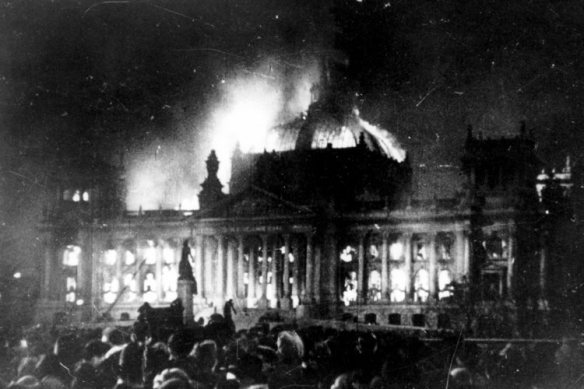Suprisingly few understand that Adolf Hitler’s Nazi Party came to power by winning democratic elections. Fewer still understand that the subsequent march from liberty to totalitarianism was made in a small number of entirely legal steps. This essay suggests something original: that a New Zealand equivalent of the German Nazi Party could assume dictatorial powers by exploiting current New Zealand law.
The German National Socialist Worker’s Party won 33% of the party vote in the November 1932 federal elections, which was eventually enough to get Hitler, the leader, appointed German Chancellor. From there, the Nazis succeeded in having all opposition banned by means of the Reichstag Fire Decree and then, later, the Enabling Act. The effect of these two pieces of legislation was to make Germany into a one-party state, with all political power held in the Nazi Party.
But wait! you cry. The New Zealand system is different to the Weimar Republic. Our Mixed Member Proportional system is designed to prevent extremists from taking power, by making it impossible for parties to get representation unless they get a proportion of votes above a predetermined threshold. This is true – but there’s a catch. The fact is, this threshold is both a precedent and a mechanism for totalitarianism.
A party needs to get at least 5% of the party vote before it is allowed to have any seats in Parliament. Any party that gets less than 5% of the vote gets no seats at all (unless they also win an electorate seat). The logic is that if you cannot command at least 5% of the vote, then it is best to exclude you (and your voters) from Parliament entirely, on the grounds that you represent a radical extremist movement.
This logic is essentially the same logic that Hitler used to ban the Communists, only wrapped up in prettier packaging.
A hypothetical New Zealand Nazi Party that knew that they were going to get, for example, 33%+ of the vote, could simply raise the MMP threshold to 30%. This would mean that a party needed 30% of the total party votes in order to be allowed to have democratic representation. This New Zealand Nazi Party would then be the only party that got over the threshold, and consequently be the only party allowed to have a seat in Parliament.
Some might object this would be undemocratic, on the grounds that it would exclude too many people from having a say. But there are already enormous numbers of people who are excluded from having a say. It is an obscenity that a party can currently get 4% of the party vote and not be allowed any representation, especially when a slimebag like David Seymour can get in with a little over 10,000 votes.
After all, if it’s permissible for a hundred thousand people to have their democratic voice silenced because of some arbitrary threshold set by anti-democratic forces, then what does it matter if that threshold is raised a bit by slightly less democratic forces? The precedent has been set, by the status quo, that such conduct is acceptable. The only question, then, is what proportion of people are to be silenced.
Raising the threshold to 30% would only change the degree of disenfranchisement. There would be no categorical change.
Effectively, those parties that could get over 5% now have colluded, and they have made it impossible for anyone who can’t get over 5% to get into Parliament. It has been decreed that any movement with fewer than 120,000 or so members will have no voice at the table. This is borderline criminal, as it makes it impossible to oppose the political class through the democratic system. If your problem is with neoliberalism, then there’s no point in voting, because the entire political class is neoliberal.
A party has to be neoliberal to get enough attention from the neoliberal mass media to get 5% of the vote in the first place, because electoral financing is doled out in proportion to how many votes a party received in the previous general election, so without already being big enough to get over the 5% threshold it’s impossible to get enough media coverage to get there. The game is completely sewn up.
The major parties can’t even point to the relatively small “wasted vote” count and say that the small size of this voting bloc is evidence that few people are dissatisfied with the system. The fact is that many, many more people might vote for alternative parties if the threshold was low enough for them to have any chance of being allowed to have representation. But when even 100,000 votes isn’t enough to get a single seat in Parliament, the will to start new parties is massively, and artificially, suppressed. So we don’t know how many voters would vote for the National-Labour-New Zealand First-Green Establishment if there was a fair threshold.
The way to get around this is simple. Not only should the 5% threshold be removed, but it should be clearly stated that the presence of such thresholds is undemocratic. As such, not only will there no longer be one but precedent is set for there never to be one in the future. Even better, we could scrap the farce that is democracy entirely – but that’s a topic for another essay.
*
If you enjoyed reading this essay, you can get a compilation of the Best VJMP Essays and Articles of 2017 from Amazon for Kindle or Amazon for CreateSpace (for international readers), or TradeMe (for Kiwis).

